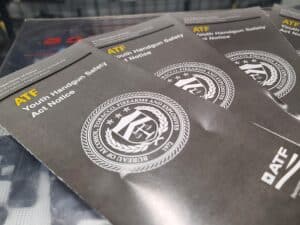More than 90 percent of the guns equipped with pistol braces remain unregistered despite the risk of potential federal felony charges. And that should come as no surprise.
On Friday, the ATF told The Reload it received just over a quarter million registration applications for braced guns in the months before last week’s deadline. That may sound like a lot at first blush, but the ATF has estimated there are three to seven million braces in circulation. The Congressional research service puts the number at between ten and 40 million.
So, somewhere between 0.6 percent and eight percent of braces have actually been registered. That’s despite a four-month grace period where the ATF waived the $200 tax the National Firearms Act (NFA) is based around. That raises further legal questions about the validity of the rule change to reclassify braced guns as NFA items in the first place, but it also demonstrates the agency was doing its best to make it as easy as possible for people to comply with the new rule. In addition to making the process free, they also hired a bunch of new employees to process all of the applications to avoid creating an even greater registration backlog than what already plagues the NFA registry.
It didn’t work. Whichever estimate you go by, there was massive non-compliance. But that’s nothing new when it comes to schemes where the government tries to register or outlaw guns years or decades after they were initially sold.
In 2013, New York attempted to register so-called assault weapons residents already owned. Hudson Valley One reported shortly afterward that only about 44,000 of the estimated million guns affected were actually registered. The Buffalo News followed up last year and found more than 40 percent of those who initially registered their weapons failed to reregister five years later as the law required.
In 2018, New Jersey lowered its magazine limit from 15 rounds to 10 while banning possession of the old magazines. As NJ.com reported in 2019, State Police reported residents didn’t turn in a single magazine to them after the law went into effect. In fact, owners rented out a giant safe to fill with affected magazines rather than turn them over as the ban faces down legal challenges.
Most recently, the bump stock ban saw almost nobody turn in the devices. In that case, registration wasn’t even an option. Owners either had to destroy them or turn them in. In the same assessment where the ATF estimated how many pistol braces are in circulation, the agency also reported only 0.105 percent of bump stocks were turned in to the agency.
The reasons the pistol-brace ban faltered are the same ones the bump stock, New York, and New Jersey bans did.
Most prominently, non-compliance is often a political act. Many owners believe these bans are unconstitutional and won’t submit to the requirements. This is especially true when there are court cases they can look to as a potential remedy.
That has been an even stronger incentive in the brace case than the state examples because the bump stock ban, which uses the same legal theory, has been struck down, and a bevy of federal judges unleashed injunctions against the brace ban as the deadline hit. Those injunctions cover the members of the Second Amendment Foundation, Firearms Policy Coalition, and Gun Owners of America. As evidence some brace owners did indeed skip registering because of the legal challenges, those groups saw a surge in membership after the injunctions were announced.
There’s another less-discussed reason the registration effort was a failure. That’s the likelihood that many owners aren’t even aware they were supposed to register their guns. While gun news junkies and dedicated gun-rights advocates have paid close attention to the ban over the past year, the average person likely isn’t even aware of it.
Millions of people bought braced guns during the time the ATF previously said they weren’t NFA items that needed to be registered. So, there are likely many people who walked into a gun store five or ten years ago and walked out with a gun they had no reason to believe would later become a felony to possess. Lots of those people are unlikely to watch political guntubers or read The Reload (though, more definitely should!), and major media has paid very little attention to the brace ban (not that most Americans follow even major news outlets on a daily basis these days anyway).
And, despite it being a common fear in the gun-rights movement, the ATF or any other law enforcement agency are unlikely to have shown up at their door to let them know about the ban either. The reality with modern registration and/or confiscation scheme is that they are often coupled with lax enforcement.
There has been no door-to-door effort to enforce the New York and New Jersey bans. New Jersey officials were unable to articulate any concrete plan for enforcing its magazine limits when asked by the Washington Free Beacon. There haven’t been mass arrests or indictments over either law.
As with the bump stock ban, the ATF has publicly speculated many Americans have disposed of or dismantled their braced guns to comply with the rule on a sort of honor system. They haven’t announced any plans for further enforcement either.
What’s most likely to happen with these bans is they get used as tack-on charges for those suspected of committing more serious crimes. And anyone else who holds on to them is unlikely to face legal action in large part because they’re unlikely to come into contact with law enforcement at all.
But that doesn’t mean these bans will have no practical effect. Instead, it means the impact will be long-term. Because the people who will be forced to comply with them are manufacturers and dealers. The supply of the banned guns and accessories will be choked off over time, and the prohibition on them will become normalized.
This happened with machineguns. In 1934, all fully-automatic firearms were subject to the tax and registration law the braced guns now fall under. This effort faced significant non-compliance too, as evidenced by the 1968 registration amnesty. In 1986, new sales of fully-automatic guns were banned outright.
Today, while some gun-rights activists want the machinegun regulations repealed, they are broadly popular and relatively accepted. The ATF is far more aggressive in pursuing unregistered machineguns today than they have been with bump stocks and pistol braces. Gun owners are far less eager to possess unregistered machineguns too.
Still, all of this is very bad news for those who believe registering and/or confiscating all or some guns is a practical solution for mass shootings or other forms of gun murder. Not only does it show that Americans are highly unlikely to comply with any effort like that. But it would take a generation or more to start seeing an effect similar to what happened with machineguns, which were first required to be registered almost a hundred years ago.
Plus, a broader ban is likely to engender even greater resistance. Machineguns, bump stocks, and pistol braces are not nearly as popular as handguns or AR-15s. Even the high-end estimate of 40 million braced guns pales in comparison to the almost 400 million guns American civilians own.







3 Responses
As always, great analysis Stephen.
I think at the end though you may be understating the number of guns in the U.S. NSSF had and article in December 2019 (https://www.nssf.org/articles/nssf-releases-firearms-production-figures/) that estimated 423 million guns. That news release relies on ATF reports that list firearms manufactured, exported and imported through 2018. We know that tens of millions of guns have entered commerce since then. I think the gun stock in the U.S. is closer to 500 million now.
Thanks for the kind words, Jason!
Yes, the estimate I’m using is from the 2018 Small Arms Survey. So, it’s very likely the number of guns in civilian circulation is significantly higher today, especially since the biggest gun sales years are all after 2018. I usually just stick with official estimates from the Small Arms Survey in large part because they also estimate gun stocks for the US police (about 1 million) and military (about 4 million). So, there’s more of an ability to compare apples to apples.
Those comparisons didn’t matter in this particular story. But I try to use the same numbers whenever possible.
Thanks for explaining the source of the number you use. At least now I know it is also an estimate that is several years old. Keep up the good work.